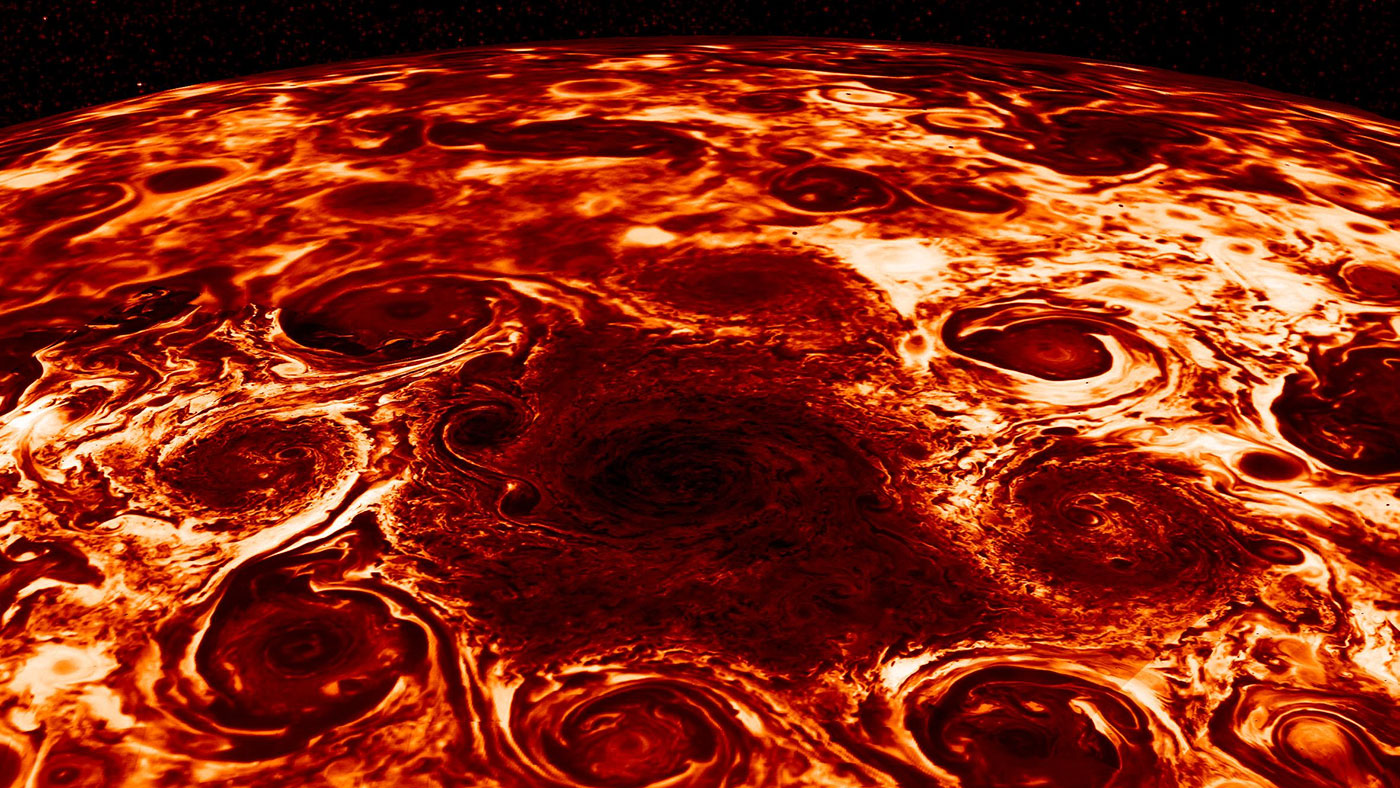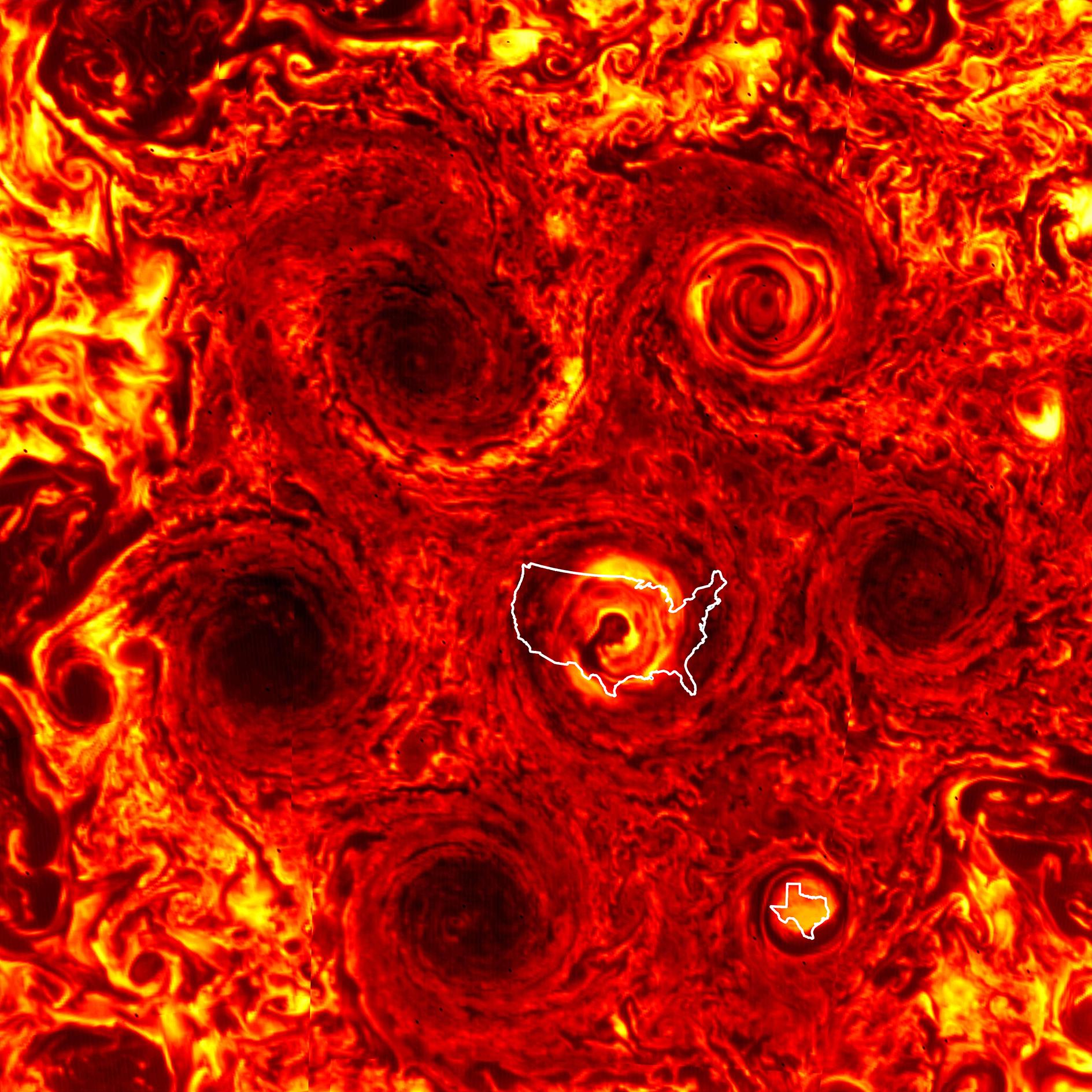Mystery of Jupiter's persistent geometric storms may be solved
But scientists still don't know how the weird storms formed.

The mystery of how giant cyclones stay together in geometric patterns around the poles of Jupiter may now be solved, but new questions have emerged as to how these clusters formed in the first place, a new study finds.
After NASA's Juno probe entered orbit around Jupiter in 2016, the spacecraft discovered giant cyclones arranged in geometric patterns around the world's poles. At the planet's north pole, there are eight vortices surrounding a central vortex, and at the south pole there are six.
"We were surprised that Jupiter's poles are not like those of other planets," study lead author Cheng Li, a planetary scientist at the University of California, Berkeley, told Space.com. "We never saw anything before like these clusters of cyclones organized into regular patterns."
Related: Soar over Jupiter's monster polar storms with this stunning NASA video
Each gargantuan tempest ranges between 2,485 to 4,350 miles (4,000 to 7,000 kilometers) wide, and they encircle their respective poles at distances of 5,400 miles (8,700 km). These cyclones and these patterns have endured for at least four years since Juno arrived at Jupiter.
It was a mystery to scientists as to how these clusters kept stable. On Earth, cyclones drift poleward but dissipate over land and cold water, Li said. In contrast, Jupiter has neither land nor oceans, raising the question of why the cyclones did not simply drift to the poles and merge. (For instance, Saturn has a single cyclone at each of its poles.)
"All previous theories predicted that polar regions of giant planets should be dominated by big cyclones over their poles, like what's being observed at Saturn, or remain chaotic," said Li, who is taking a new position at the University of Michigan at Ann Arbor. "What we see at Jupiter means those previous theories are wrong, and we need something new."
Get the Space.com Newsletter
Breaking space news, the latest updates on rocket launches, skywatching events and more!
Related: The most powerful storms of the solar system (photos)
To shed light on Jupiter's cyclones, Li and his colleagues developed computer models based on what Juno revealed about the sizes and speeds of the storms. They focused on what factors might keep these geometric patterns stable over time without merging.
The researchers found the stability of these patterns depend partly on how deep the cyclones reach down into Jupiter's atmosphere, but mostly on anticyclonic rings around each cyclone — that is, a ring of wind spinning in the opposite direction that each cyclone is whirling in. Too little shielding from anticyclone rings led to the cyclones merge; too much shielding could drive the cyclones apart from each other.
There are many unsolved mysteries regarding these clusters of cyclones. For example, it remains unknown why Jupiter's vortexes happen to occupy this happy middle between too much and too little shielding. "Right now we have no idea what makes them sit in this sweet spot," Li said.
The scientists are now investigating how these cyclones might have formed in the first place. One possibility is that they formed near the poles, where they are currently located. The other, "which we think is more likely, is they formed elsewhere and then migrated to the poles," Li said.

Once the researchers generate computer models based on data from Juno to see which of these formation scenarios is more likely, they can then begin to see how these cyclones organize themselves into these stable patterns.
This may prove a more difficult question to answer, "because that involves detailed 3-D modeling of how these vortices are generated, and there are a lot of parameters about these vortices we do not know, such as their vertical structure," Li said. "But we can try different scenarios to see which vertical structures might generate the wind velocity profiles we have observed with these cyclones and move forward from there."
The scientists detailed their findings online Sept. 7 in the journal Proceedings of the National Academy of Sciences.
Follow Charles Q. Choi on Twitter @cqchoi. Follow us on Twitter @Spacedotcom and on Facebook.
Join our Space Forums to keep talking space on the latest missions, night sky and more! And if you have a news tip, correction or comment, let us know at: community@space.com.

Charles Q. Choi is a contributing writer for Space.com and Live Science. He covers all things human origins and astronomy as well as physics, animals and general science topics. Charles has a Master of Arts degree from the University of Missouri-Columbia, School of Journalism and a Bachelor of Arts degree from the University of South Florida. Charles has visited every continent on Earth, drinking rancid yak butter tea in Lhasa, snorkeling with sea lions in the Galapagos and even climbing an iceberg in Antarctica. Visit him at http://www.sciwriter.us
-
rod The space.com link provided says "Significance Like good wine, scientific problems gain significance as they age. Regular patterns of vortices have been studied theoretically and observed in the laboratory since the 19th century, but never before in a planetary atmosphere, with the complicating effects of planetary rotation, spherical geometry, and horizontal convergence and divergence. Instruments on the Juno spacecraft have given us the sizes and speeds of the vortices, but a true understanding requires a numerical model that matches the observations and simulates the long-term stability of the patterns. We provide such a model here, but the work is not done. We will make further progress as Juno continues its observations of this fascinating phenomenon.", https://www.pnas.org/content/early/2020/09/01/2008440117Reply
Some computer geeks and math geeks will continue to have fun here as the work continues :) -
JakeTimbers gas structures as big as planets, extremely compressed tell the point they have enough matter to build their own gravity well until self sustaining. By dropping compressed gas down the center, making the solar systems largest toilet flush.Reply -
Esarechavala Well I'm not in any way possible a scientist, astrophysicist. From a completely non science view. The description and photo kind of looks like (using imagination) a set of gears from a clock or gearbox each one dependent on the turning of one of it's neighbors rotation somehow. Just a random thought.Reply -
Patrick Gisler I suspect that solids may play a role by interfering with fluid flow of the atmosphere. A few hundred kilometers below cloud tops, higher pressures should give rise to ammonium ice, water ice, solid ammonium hydrogen sulfide and probably some other solid substances. These solids ( dust, sand, mushballs, floating islands? ) are part of cycles of phase changes in the atmosphere. The von Karmann interference patterns exhibited in the flow patterns of cloud tops are a clue that the fluid flow is subject to interference by solids below, more than just other directions of gas flow.Reply









